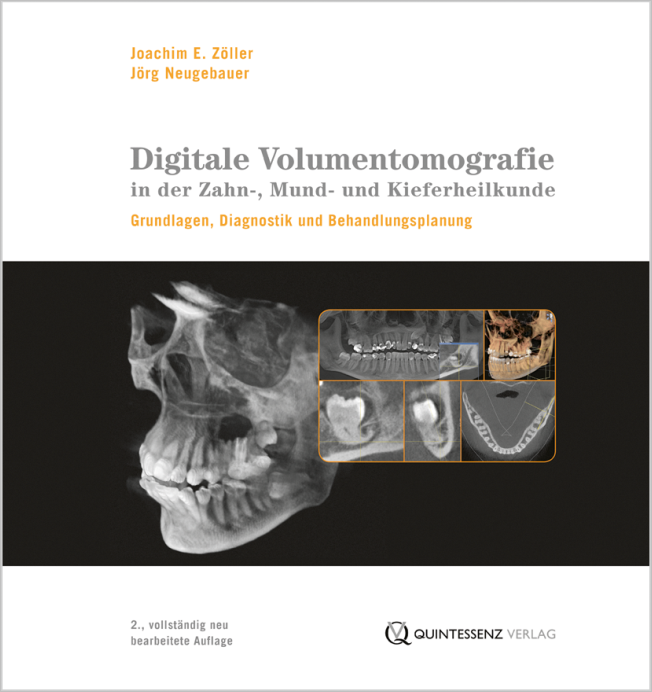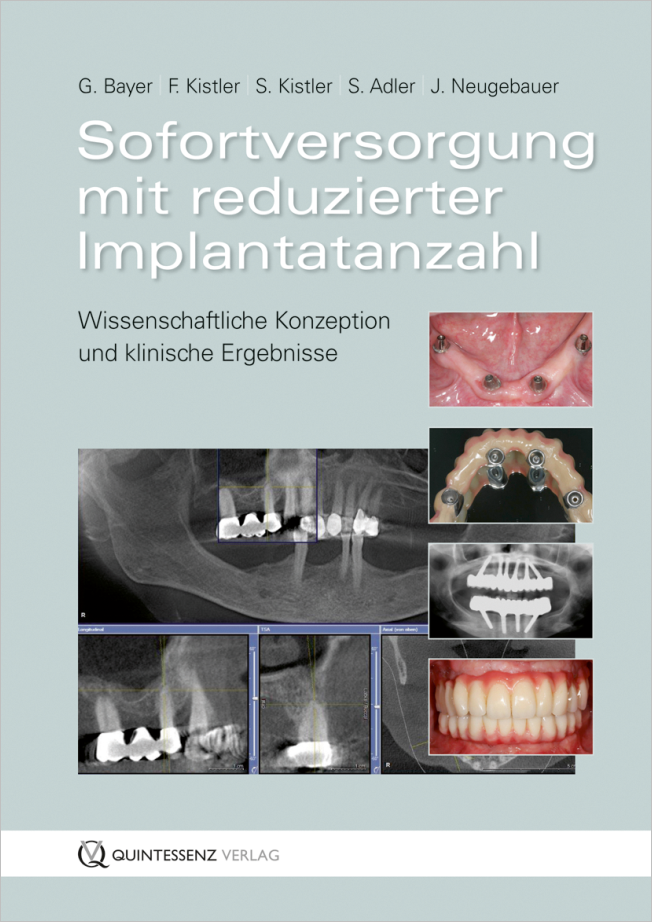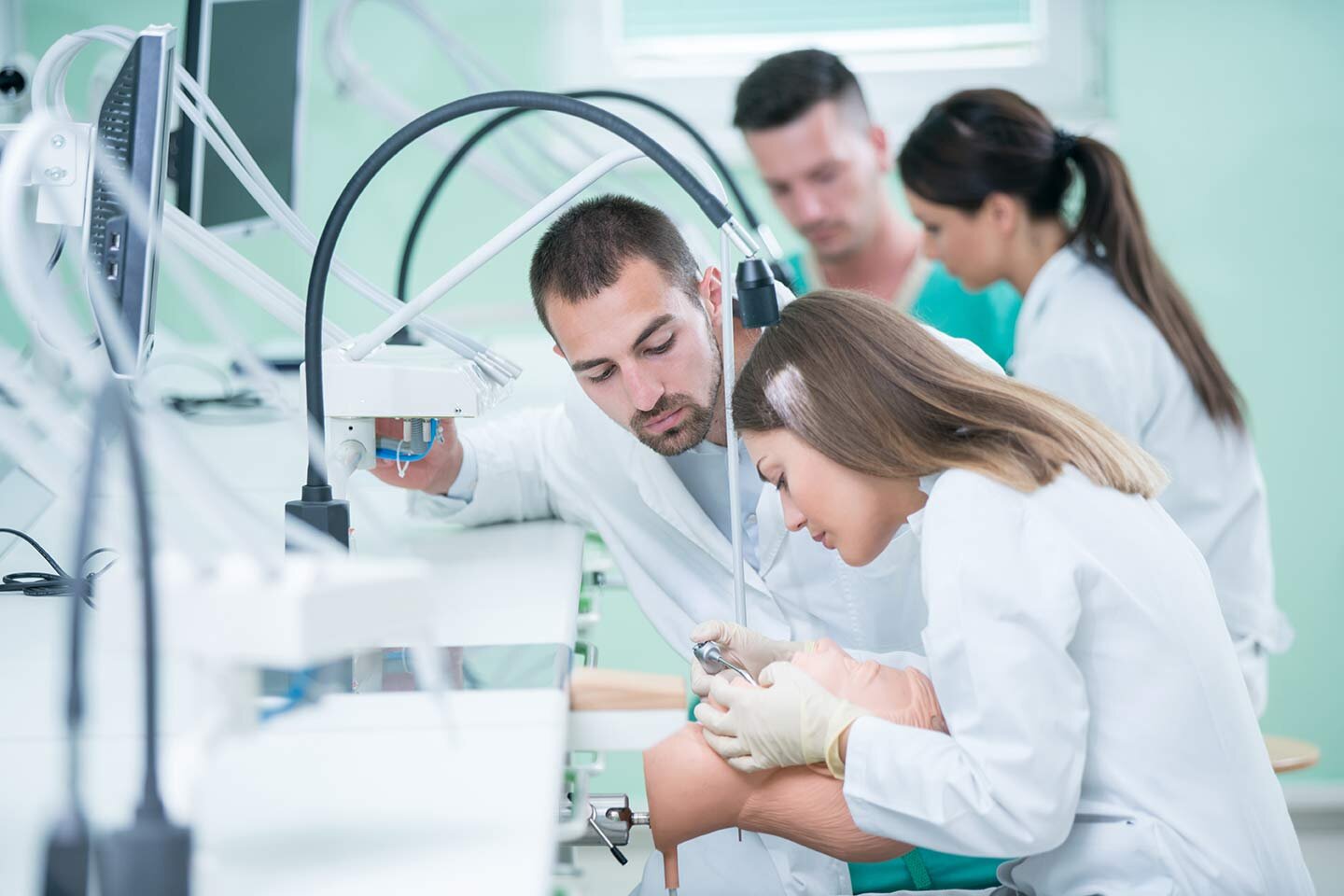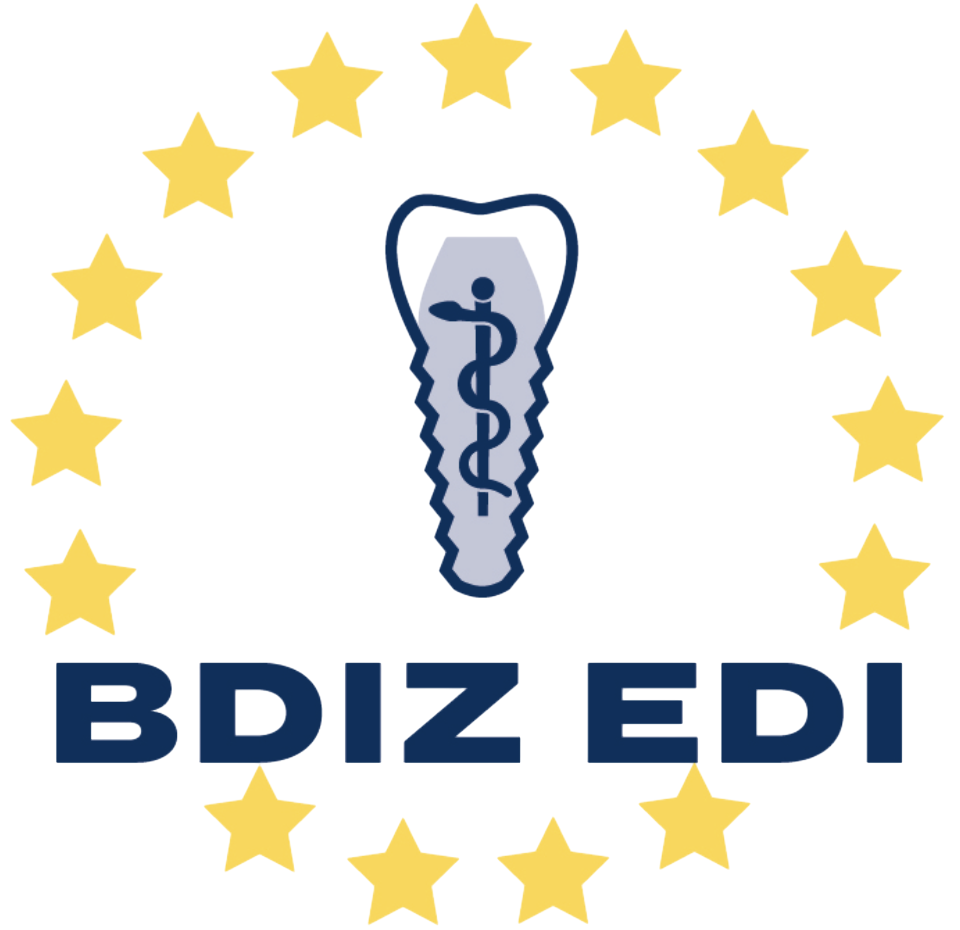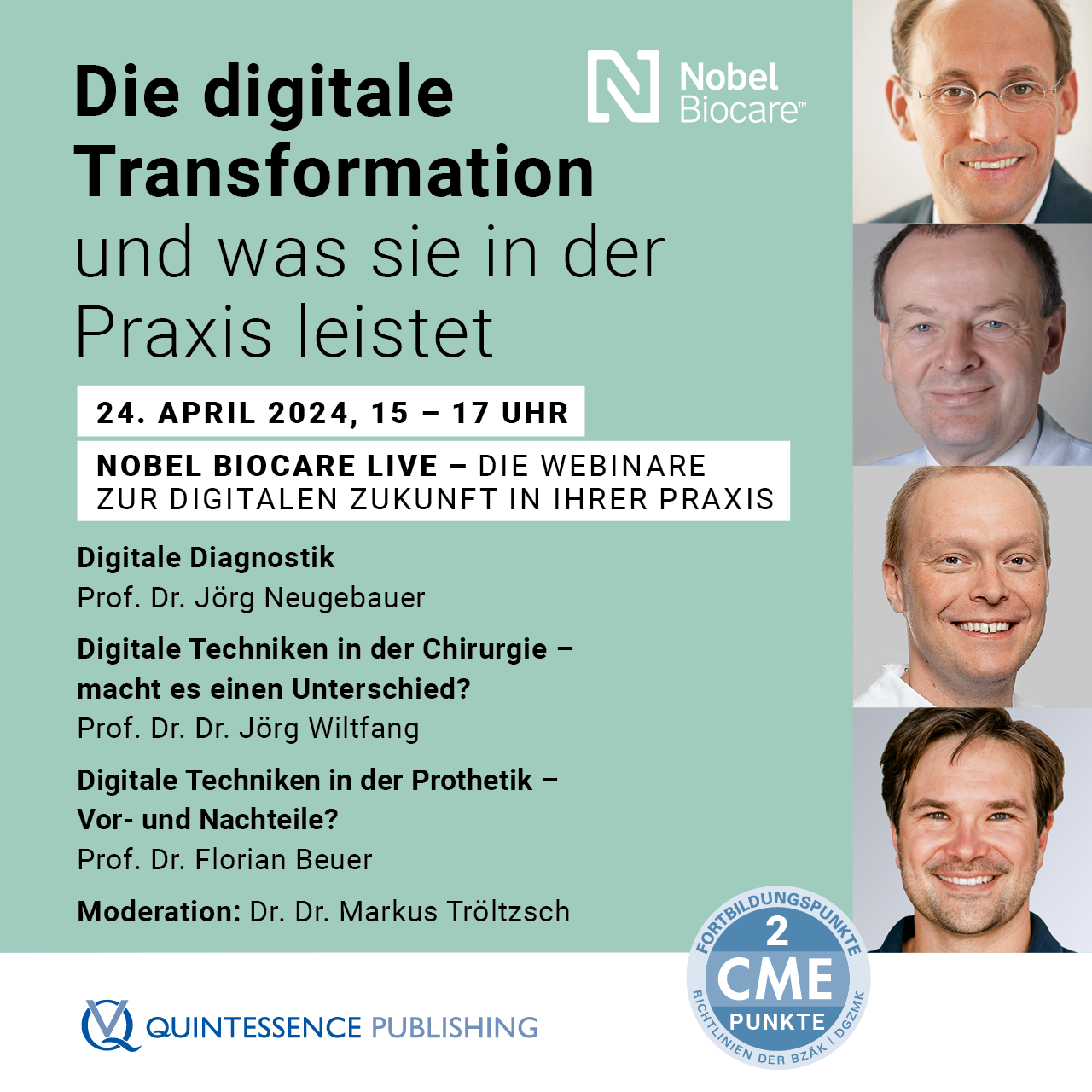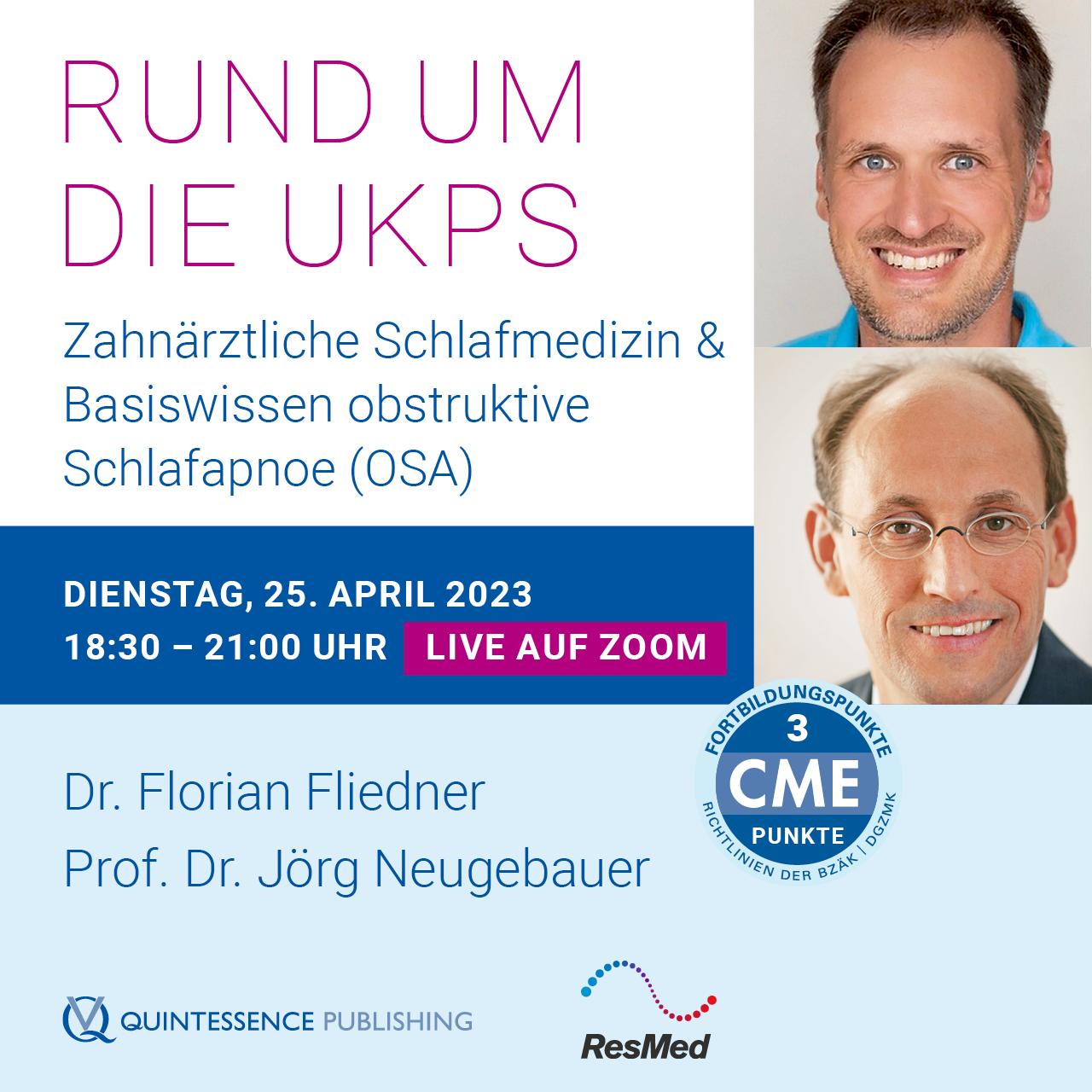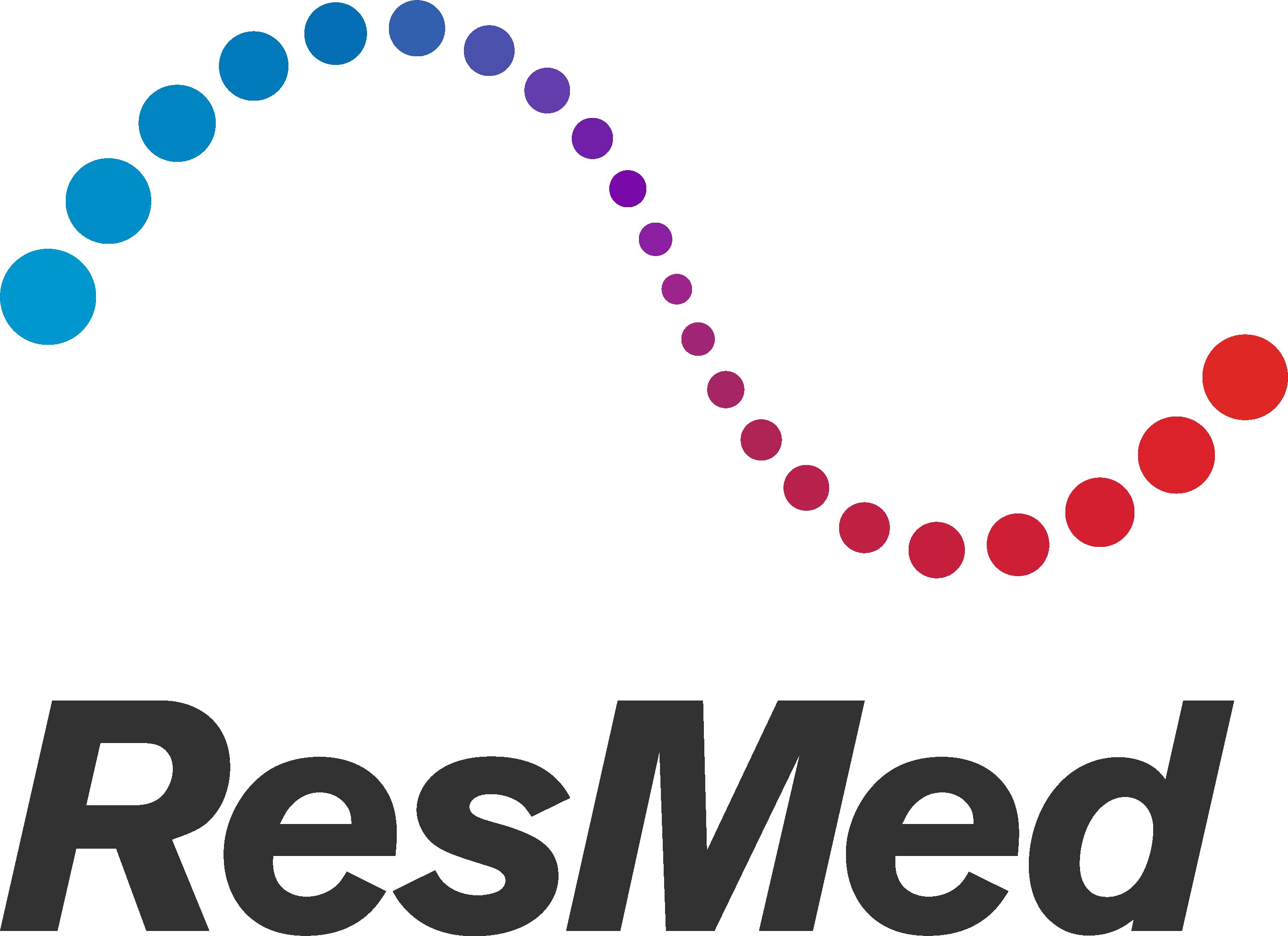The International Journal of Oral & Maxillofacial Implants, 2/2025
DOI: 10.11607/jomi.10574, PubMed ID (PMID): 39485909Pages 188-196, Language: EnglishHenn, Paul / Gehrke, Peter / Happe, Arndt / Neugebauer, JörgPurpose: To conduct a retrospective study on the marginal bone level (MBL) of reduced diameter implants (RDIs) to analyze them in the context of various surgical and prosthetic treatment strategies using heterogeneous data from a private practice. Materials and Methods: A total of 123 patients were treated with 326 implants. Of those implants, 247 of them were RDIs, and the remaining 79 implants were standard-diameter implants (SDIs) as patient-related controls. The mean observation time was 24.4 months, and the maximum observation time 76.0 months. The peri-implant bone level of the implants was evaluated, while considering the diameter, time of implant placement, time of loading, extent of augmentation, and localization of the implants. The data were evaluated after restructuring using a mixed model analysis. Results: No significant difference was found between the use of RDIs or SDIs in the analyzed indications. Furthermore, no significant difference was found for the implant placement time, loading time, or the use of two-stage augmentations regarding the stability of the peri-implant bone level. Conclusions: Reduced-diameter implants are a sufficient treatment option in horizontally deficient bone conditions. The use of RDIs in the posterior region shows promising results; 3.5-mm- diameter implants may be indicated considering the individual patient situation. The use of a mixed model analysis for the evaluation of heterogeneous practice data can lead to a significant increase in the number of retrospective studies and data integration from practices, forming a sound basis for evidence-based dentistry.
Keywords: bone augmentation, dental implants, implant diameter, marginal bone level, mixed model analysis
QZ - Quintessenz Zahntechnik, 6/2024
FallstudiePages 608-617, Language: GermanAdler, Stephan / Kistler, Steffen / Kistler, Frank / Frank, Ingo / Neugebauer, JörgAltersgerechte, langfristige Implantatversorgung im OberkieferDer Fallbericht zeigt anhand einer Fullarch- Implantatbrücke im Oberkiefer eines älteren Patienten das Potenzial digitaler Zahntechnik. Dargestellt werden die einzelnen Phasen von der interdisziplinären Planung gemeinsam mit dem Zahnarzt über das Provisorium bis zur definitiven Versorgung mit einer bemalten Zirkonbrücke. Wichtig für die Zufriedenheit des Patienten sind verlässliche Vorhersagen, Zeitund Kosteneffizienz und ein hoher Patientenkomfort. Die gleichbleibend hohe Präzision der digitalen Verfahren und Komponenten bieten dafür entscheidende Vorteile.
Keywords: Zirkonoxid, digitaler Workflow, interdisziplinär, Implantatprothetik, festsitzende Versorgung
Implantologie, 4/2024
Pages 383-394, Language: GermanNeugebauer, Jörg / Ritter, Lutz / Kistler, Steffen / Kistler, Frank / Dhom, Günter / Scheer, MartinDie digitale Planung und Diagnostik in der Zahnmedizin, insbesondere im Bereich der Implantologie, hat in den letzten Jahren erhebliche Fortschritte gemacht. Die dreidimensionale Bildgebung ist, vor allem durch die digitale Volumentomografie (DVT), zu einem hilfreichen Instrument für die genaue Positionierung von Implantaten, die Anwendung minimal invasiver Techniken und die Planung von Knochenaufbaumaßnahmen geworden. Die DVT bietet zwar eine höhere diagnostische Genauigkeit, ist aber im Vergleich zur herkömmlichen zweidimensionalen Bildgebung mit einer höheren Strahlendosis verbunden. Moderne DVT-Geräte bieten verschiedene Einstellungen, um eine indikationsbedingte Bildgebung bei minimaler Strahlenbelastung zu erhalten. Die DVT wird bei verschiedenen klinischen Indikationen wie der CAD/CAM-unterstützen Augmentationschirurgie und der Navigationschirurgie, die eine minimalinvasive Implantatinsertion ermöglichen, genutzt. Angesichts der höheren Strahlendosis ist es wichtig, die individuellen Einstellungsparameter so zu wählen, dass der diagnostische und therapeutische Nutzen höher als das mögliche Risiko ist. Die effektive Umsetzung dieser Technologien erfordert Schulungen und die Einrichtung standardisierter Arbeitsabläufe, um die Behandlungsergebnisse zu verbessern und die Morbidität der Patienten zu verringern.
Keywords: DVT, minimalinvasive Implantattherapie, Navigationsschablone, Strahlenbelastung
The International Journal of Oral & Maxillofacial Implants, 7/2023
SupplementDOI: 10.11607/jomi.10411, PubMed ID (PMID): 37436948Pages 37-45o, Language: EnglishSchoenbaum, Todd R / Karateew, E Dwayne / Schmidt, Angela / Jadsadakraisorn, Chaniun / Neugebauer, Jörg / Stanford, Clark MPurpose: To quantify the cumulative oral implant survival rates and changes in radiographic bone levels based on the configuration of the implant-abutment connection type over time.
Materials and Methods: An electronic literature search was conducted in four databases (PubMed/MEDLINE, Cochrane Library, Web of Science, and Embase), and records were refereed by two independent reviewers based on the inclusion criteria. Data from included articles were grouped by implant-abutment connection type into four categories ([1] external hex; [2] bone level, internal, narrow cone < 45 degrees; [3] bone level, internal wide cone ≥ 45 degrees or flat; and [4] tissue level) and duration of follow-up (short-term 1 to 2 years, mid-term 2 to 5 years, and long-term > 5 years). Meta-analyses were performed for cumulative survival rate (CSR) and changes in marginal bone level (ΔMBL) from baseline (loading) to last reported follow-up. Studies were split or merged as appropriate based on the implants and follow-up duration in the study and trial design. The study was compiled under PRISMA 2020 guidelines and registered in the PROSPERO database.
Results: A total of 3,082 articles were screened. Fulltext review of 465 articles resulted in a total of 270 articles (representing 16,448 subjects with 45,347 implants) included for quantitative synthesis and analysis. Mean ΔMBL (95% CI) was as follows: short-term external hex = 0.68 mm (0.57, 0.79); short-term bone level, internal, narrow cone < 45 degrees = 0.34 mm (0.25, 0.43); short-term bone level, internal wide cone ≥ 45 degrees = 0.63 mm (0.52, 0.74); short-term tissue level = 0.42 mm (0.27, 0.56); mid-term external hex = 1.03 mm (0.72, 1.34); mid-term bone level, internal, narrow cone < 45 degrees = 0.45 mm (0.34, 0.56); mid-term bone level, internal wide cone ≥ 45 degrees = 0.73 mm (0.58, 0.88); mid-term tissue level = 0.4 mm (0.21, 0.61); long-term external hex = 0.98 mm, 0.70, 1.25); long-term bone level, internal, narrow cone < 45 degrees = 0.44 mm (0.31, 0.57); long-term bone level, internal wide cone ≥ 45 degrees = 0.95 mm (0.68, 1.22); and long-term tissue level = 0.43 mm (0.24, 0.61). CSRs (95% CI) were: short-term external hex = 97% (96%, 98%); short-term bone level, internal, narrow cone < 45 degrees = 99% (99%, 99%); short-term bone level, internal wide cone ≥ 45 degrees = 98% (98%, 99%); short-term tissue level = 99% (98%, 100%); mid-term external hex = 97% (96%, 98%); mid-term bone level, internal, narrow cone < 45 degrees = 98% (98%, 99%); midterm bone level, internal wide cone ≥ 45 degrees = 99% (98%, 99%); mid-term tissue level = 98% (97%, 99%); long-term external hex = 96% (95%, 98%); long-term bone level, internal, narrow cone < 45 degrees = 98% (98%, 99%); long-term bone level, internal wide cone ≥ 45 degrees = 99% (98%, 100%); and long-term tissue level = 99% (98%, 100%).
Conclusion: The configuration of the implant-abutment interface has a measurable effect on the ΔMBL over time. These changes can be observed over a period of at least 3 to 5 years. At all measured time intervals, similar ΔMBL was noted for external hex and internal wide cone ≥ 45-degree connections, as were internal, narrow cone < 45-degree and tissue-level connections.
Keywords: abutment, bone level, bone loss, connection, failure, implant, review, survival
The International Journal of Oral & Maxillofacial Implants, 7/2023
SupplementDOI: 10.11607/jomi.10500, PubMed ID (PMID): 37436947Pages 30-36, Language: EnglishNeugebauer, Jörg / Schoenbaum, Todd R / Pi-Anfruns, Joan / Yang, Min / Lander, Bradley / Blatz, Markus B / Fiorellini, Joseph PPurpose: To evaluate the performance of one- and two-piece ceramic implants regarding implant survival and success and patient satisfaction.
Materials and Methods: This review followed the PRISMA 2020 guidelines using PICO format and analyzed clinical studies of partially or completely edentulous patients. The electronic search was conducted in PubMed/MEDLINE using Medical Subject Headings (MeSH) keywords related to dental zirconia ceramic implants, and 1,029 records were received for detailed screening. The data obtained from the literature were analyzed by single-arm, weighted meta-analyses using a random-effects model. Forest plots were used to synthesize pooled means and 95% CI for the change in marginal bone level (MBL) for short-term (1 year), mid-term (2 to 5 years), and long-term (over 5 years) follow-up time intervals.
Results: Among the 155 included studies, the case reports, review articles, and preclinical studies were analyzed for background information. A meta-analysis was performed for 11 studies for one-piece implants. The results indicated that the MBL change after 1 year was 0.94 ± 0.11 mm, with a lower bound of 0.72 and an upper bound of 1.16. For the mid term, the MBL was 1.2 ± 0.14 mm with a lower bound of 0.92 and an upper bound of 1.48. For the long term, the MBL change was 1.24 ± 0.16 mm with a lower bound of 0.92 and an upper bound of 1.56.
Conclusion: Based on this literature review, one-piece ceramic implants achieve osseointegration similar to titanium implants, with a stable MBL or a slight bone gain after an individual initial design depending on crestal remodeling. The risk of implant fracture is low for current commercially available implants. Immediate loading or temporization of the implants does not interfere with the course of osseointegration. Scientific evidence for two-piece implants is rare.
Keywords: ceramic implants, implant survival, marginal bone level, systematic review, titanium implant
Implantologie, 4/2022
Pages 387-398, Language: GermanHappe, Arndt / Debring, Leonie / Schmidt, Alexander / Fehmer, Vincent / Neugebauer, JörgEine randomisierte kontrollierte klinisch-volumetrische Studie Die Bindegewebetransplantation zählt heute zu den Standardverfahren zur Kompensation von Volumendefiziten bei Sofortimplantation. Neue Biomaterialien wie azelluläre Matrices könnten die Gewinnung autogenen Gewebes auf ein absolut notwendiges Minimum reduzieren und damit die Häufigkeit und das Ausmaß postoperativer Beschwerden verringern. Die vorliegende randomisierte Studie verglich die klinischen Therapieergebnisse von Sofortimplantationen in der Oberkieferfront, bei denen sowohl eine knöcherne Augmentation als auch eine Weichgewebeverdickung durchgeführt wurde. Neben anorganischem bovinem Knochenmaterial (ABBM) kam entweder ein Bindegewebeersatz aus porciner Dermis, eine azelluläre dermale Matrix (ADM) oder ein autogenes Bindegewebetransplantat (BGT) zum Einsatz. An der Studie nahmen 20 Patienten (11 Männer, 9 Frauen) mit einem Durchschnittsalter von 48,9 Jahren (21−72 Jahre) teil. Die Zuordnung der Studienteilnehmer zu der Test- (ADM) bzw. Kontrollgruppe (BGT) geschah nach dem Zufallsprinzip. Der Zahnextraktion folgte die sofortige Implantatinsertion. Der bukkale Knochen wurde mit ABBM augmentiert. Eine ADM oder ein BGT diente zur Verdickung des bukkalen Weichgewebes und somit zur Kompensation des erwarteten Verlustes von bukkalem Volumen. Die klinische und volumetrische Nachuntersuchung fand 12 Monate nach Implantatinsertion statt. Bei allen Implantaten hatte eine Osseointegration stattgefunden und die prothetische Versorgung befand sich in situ. Ein Jahr postoperativ betrug die durchschnittliche, linear gemessene Volumenveränderung −0,55 ± 0,32 mm (ADM) bzw. −0,60 ± 0,49 mm (BGT). Patienten der ADM-Gruppe beklagten signifikant weniger postoperative Beschwerden. Bei Sofortimplantation mit Augmentation von Hart- und Weichgewebe führten Ersatzmaterialien und autogene Bindegewebetransplantate zu ähnlichen klinischen Ergebnissen hinsichtlich der gemessenen Volumenveränderungen. Die Anwendung von Ersatzmaterial führte zu signifikant weniger postoperativer Morbidität.
Manuskripteingang: 07.01.2021, Annahme: 14.04.2021
Keywords: Sofortimplantation, Weichgewebeverdickung, Bindegewebetransplantat, azelluläre dermale Matrix, anorganisches bovines Knochenmaterial
Implantologie, 3/2022
Pages 263-272, Language: GermanKistler, Steffen / Kistler, Frank / Neugebauer, JörgFaktoren für den LangzeiterfolgDie Sofortimplantation mit Sofortversorgung in der ästhetischen Zone stellt eine Möglichkeit des langzeitstabilen Erhalts der periimplantären Weichgewebestrukturen dar. Neben der idealen Positionierung des Implantats ist die Gestaltung der provisorischen Versorgung essenziell für eine stabile Regeneration. Durch die Anwendung von Implantaten mit einem Plattform-Switch und einer bewussten Unterkonturierung kann sich ein Weichgewebesaum ausbilden, der über Jahre stabil bleibt und die Patientenerwartungen in der ästhetischen Zone erfüllt.
Manuskripteingang: 26.07.2022, Annahme: 03.08.2022
Keywords: Sofortimplantation, Sofortversorgung, provisorische Versorgung, Plattform-Switch, Langzeitergebnis
International Journal of Periodontics & Restorative Dentistry, 3/2022
DOI: 10.11607/prd.5632Pages 381-390, Language: EnglishHappe, Arndt / Debring, Leonie / Schmidt, Alexander / Fehmer, Vincent / Neugebauer, JörgConnective tissue grafts have become a standard for compensating horizontal volume loss in immediate implant placement. The use of new biomaterials like acellular matrices may avoid the need to harvest autogenous grafts, yielding less postoperative morbidity. This randomized comparative study evaluated the clinical outcomes following extraction and immediate implant placement in conjunction with anorganic bovine bone mineral (ABBM) and the use of a porcine acellular dermal matrix (ADM) vs an autogenous connective tissue graft (CTG) in the anterior maxilla. Twenty patients (11 men, 9 women) with a mean age of 48.9 years (range: 21 to 72 years) were included in the study and randomly assigned to either the test (ADM) or control (CTG) group. They underwent tooth extraction and immediate implant placement together with ABBM for socket grafting and either ADM or CTG for soft tissue augmentation. Twelve months after implant placement, the cases were evaluated clinically and volumetrically. All implants achieved osseointegration and were restored. The average horizontal change of the ridge dimension at 1 year postsurgery was -0.55 ± 0.32 mm for the ADM group and -0.60 ± 0.49 mm for the CTG group. Patients of the ADM group reported significantly less postoperative pain. Using xenografts for hard and soft tissue augmentation in conjunction with immediate implant placement showed no difference in the volume change in comparison to an autogenous soft tissue graft, and showed significantly less postoperative morbidity.
International Journal of Computerized Dentistry, 1/2022
SciencePubMed ID (PMID): 35322651Pages 37-45, Language: English, GermanHappe, Arndt / von Glasser, Gerrit Schulze / Neugebauer, Jörg / Strick, Kilian / Smeets, Ralf / Rutkowski, RicoAim: To evaluate the survival of implant-retained restorations fabricated on CAD/CAM-derived zirconia abutments luted to a titanium base.
Materials and methods: 153 patients who received a total of 310 dental implants (Camlog Promote plus or Xive S) and all-ceramic restorations on yttria-stabilized tetragonal zirconia polycrystal (3Y-TZP) abutments luted to a titanium base during the last 10 years were included. Patients were examined for technical complications during routine visits. Crestal bone level changes were randomly analyzed based on periapical radiographs of 75 implants.
Results: Among the included 153 patients, 17 ceramic chippings (5.5%), 6 abutment loosenings (1.9%), and 2 abutment fractures (0.6%) were identified. The mean follow-up time was 4.7 years (standard deviation [SD]: 1.94), with a follow-up period of up to 10 years (maximum). Kaplan-Meier estimation resulted in a survival rate without complications of 91.6% for the restoration and 97.4% for the abutment. There was no statistically significant difference between the two implant systems, either between implant location or regarding the complication rate of the type of restoration. For the 75 implants included in the radiographic analysis, the mean bone level change was 0.384 mm (SD: 0.242, 95% CI: 0.315 to 0.452) for the Camlog implant system and 0.585 mm (SD: 0.366, 95% CI: 0.434 to 0.736) for the Xive system (P = 0.007).
Conclusion: The results of the present retrospective study demonstrate acceptable clinical outcomes for zirconia abutments luted to a titanium base in combination with all-ceramic restorations. The assessed abutment design does not appear to have a negative impact on peri-implant hard tissue.
Keywords: implant abutment, zirconia abutment, titanium base, two-piece abutment, implant restoration
The International Journal of Oral & Maxillofacial Implants, 6/2021
DOI: 10.11607/jomi.8103Pages 1211-1218, Language: EnglishGrandoch, Andrea / Peterke, Nico / Hokamp, Nils Grosse / Zöller, Joachim E / Lichenstein, Thorsten / Neugebauer, Jörg
Purpose: Cone beam computed tomography (CBCT) is considered both reliable and safe and provides reproducible results in guided dental implant planning procedures. However, it has weaknesses in soft tissue contrast and is associated with radiation exposure. Recent studies showed promising results with magnetic resonance imaging (MRI) as a possible noninvasive, radiation-free, alternative imaging modality for dental indications. The purpose of this study was to evaluate the quality of 1.5 T MRI with a dedicated dental signal-amplification coil in comparison to CBCT for dental implant planning procedures.
Materials and methods: Sixteen subjects undergoing preoperative MRI (3D HR T1w TSE and 3D HR T1w FFE) and CBCT were included in this prospective study. All imaging data were used for dental implant planning procedures using commercially available software. Two experts scored the planning as "ideal," "improvable," or "unacceptable." Furthermore, quantitative distances according to EuCC recommendations were collected. Finally, discrepancies between CBCT and 3D HR T1w TSE were analyzed. Statistical analysis was performed using the Mann-Whitney U test and analysis of variance (ANOVA).
Results: The dental implant planning procedure was technically feasibly using all imaging data. CBCT allowed for "ideal" placement in all cases. Ratings for 3D HR T1w TSE and 3D HR T1w FFE were 81.9%, 18.1%, and 0% and 54.2%, 30.0%, and 15.3% for ideal, improvable, and unacceptable, respectively, identifying 3D HR T1w TSE as superior compared with 3D HR T1w FFE. Head-to-head comparison between CBCT and 3D HR T1w TSE revealed no significant differences regarding the apical position of the implant of 1.2 ± 0.7 mm and 1.3 ± 0.5 mm coronally, respectively (P = .287). The deviation of the planed angle was 3.0 ± 1.2 degrees. In these merged data sets, the distance to the mandibular canal was significantly higher with 1.3 ± 0.8 mm, indicating better utilization of the existing bone.
Conclusion: Within the limits of this pilot study, it can be reported that the dental image planning procedure is feasible using 1.5 T MRI with a dedicated dental coil and specific MRI sequences.
Keywords: cone beam computed tomography (CBCT), magnetic resonance imaging (MRI), dental signal amplification coil, surgical guide, dental implant surgery





